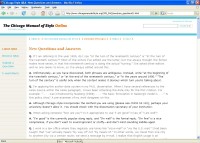Aggressive advice from our manuscript editors
 Every month the manuscript editors at the Press field questions submitted to The Chicago Style Q&A, a feature of the new Chicago Manual of Style Online. Our manuscript editors respond to these questions with serious explications of the subtleties of style and usage, although they cannot resist the occasional—well, maybe more than occasional—diversion into delicious irony.
Every month the manuscript editors at the Press field questions submitted to The Chicago Style Q&A, a feature of the new Chicago Manual of Style Online. Our manuscript editors respond to these questions with serious explications of the subtleties of style and usage, although they cannot resist the occasional—well, maybe more than occasional—diversion into delicious irony.
This month’s Harper’s reprinted some highlights from the Q&A under the appropriately paradoxical title of “Stet Offensive,” further described on their Web site as “aggressive advice from the editors of the Chicago Manual of Style.” Here are examples of our editors’ advice:
Q: When I began learning English grammar from the nuns in 1951, I was taught never to use a comma either before or after independent clauses or compound sentences. Did the rules of English grammar and punctuation change while I was in that three week coma in 1965, or in the years it took to regain my basic and intellectual functioning before I returned to teaching?
A: I’m sorry I can’t account for your state of mind, but standard punctuation calls for a comma before a conjunction that joins two independent clauses unless the clauses are very short. I would go further and suggest that it’s a good idea to examine any rule you were taught that includes the word “never” or “always.”
Q: Is there any standard for the usage of emoticons? In particular, is there an accepted practice for the use of emoticons that includes an opening or closing parenthesis as the final token within a set of parenthesis? Should I incorporate the emoticon into the closing of the parenthesis (giving a dual purpose to the closing parenthesis, such as in this case :-); simply leave the emoticon up against the closing parenthesis, ignoring the bizarre visual effect of the doubled closing parenthesis (as I am doing here, producing a double-chin effect :-)); or avoid the situation by using a different emoticon (some emoticons are similar :-D), placing the emoticon elsewhere, or doing without it (i.e., reword to avoid awkwardness)?
A: Until academic standards decline enough to accommodate the use of emoticons, I’m afraid CMOS is unlikely to treat their styling, since the manual is aimed primarily at scholarly publications. And the problems you’ve posed in this note have given us added incentive to keep our distance.
Read more Q&A and sign up for a free trial of The Chicago Manual of Style Online.